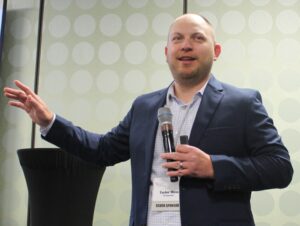
‘Leaky’ shop profit? OEC manager says there are simple fixes to consider
By onBusiness Practices
As claim severity increases and shop backlogs decrease, collision repair facilities may be noticing a difference in profit and are looking to tighten operations to keep revenues up.
That may sound daunting but it doesn’t have to be.
Taylor Moss, OEConnection repair intelligent team manager, shared some tips on how to seal up “leaky profit” during this year’s Southeast Collision Conference in May.
According to Moss, other ways the collision industry continues to evolve and is likely affecting shop profit include advanced driver assistance system (ADAS) calibrations increasing severity, parts availability recently normalizing, and the increased purchase prices of vehicles upping salvage value and, thus, total losses.
He said the most impactful and quickly fixable causes of “leaky profit” are:
-
- Weak policies
- Not capturing enough business on the front end because of poor customer service
- State of the shop’s physical presence — customers want a clean and comfortable space with free offerings, such as WiFi, snacks, or drinks
- Eating increased costs of parts, for example, by not charging customers more as those prices go up on the shop’s end
Fifty-seven people out of 100 have an estimate done after talking to a shop while only 32 proceed with having repairs done, largely due to poor communication, according to Moss’s research.
Potential customers also likely won’t call a shop back if they’re told to go get an estimate through insurance first before the shop helps them with the repair process.
Customers want to be able to make progress toward their vehicle getting back on the road at any time so shops that don’t have a way to capture customers after hours are losing business, Moss said. He recommends having AI answer after-hours calls to move customers forward in the repair process with empathy. If a caller doesn’t want to speak to AI, they can be sent to voicemail.
To improve phone communication by employees, Moss said a good idea is to use ChatGPT to create a phone script that shows empathy for the customer who’s been in a car accident, tells them the facility has advanced tools and training to fix their vehicle properly and educates them on the process of getting their car repaired.
Customers tend to like two-way texting as well, which Moss said isn’t all that expensive of a service to have on deck. In fact, a growing percentage of the collision industry customer base — Millennials and Gen Z — prefer texting over calls and emails, he said.
“The bottom line here is that the customer has been conditioned to expect nicer, better service; more white glove service than they ever had before,” Moss said. “The nicer you can make that experience, the better.”
A good online presence for your shop should be at the forefront of bringing in customers, Moss said. That’s because customers think businesses that don’t have websites aren’t legitimate or are out of business and outdated or desktop-only oriented websites conveys your shop is out of date, non-responsive, and doesn’t care about their customers, he said.
By the numbers, Moss said that looks like:
-
- 75% of people judge a company’s credibility based on its website design
- 94% of first impressions are design-related
- 38% of people stop engaging with a website that is badly designed
- 48% say web design is the most important factor in determining credibility
Websites should be easy to navigate so users can find what they’re looking for. Customers also rely heavily on online reviews when choosing a shop.
When it comes to estimators, blueprinters, and CSRs, Moss provided some questions to keep in mind:
-
- Are we finding all the operations we need to perform?
- Are we getting paid for the work we do?
- Do we bill for all the work we do?
- Do we get pushback from payers due to lack of documentation?
- Is consistency an issue?
Moss suggests using software to doublecheck estimates and repair plans for procedures and items that should be billed for that may have been missed.
Images
Featured image: Taylor Moss with OEConnection speaks during the 2024 Southeast Collision Conference in Greensboro, North Carolina. (Lurah Lowery/Repairer Driven News)
